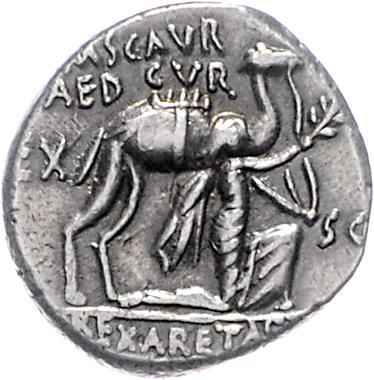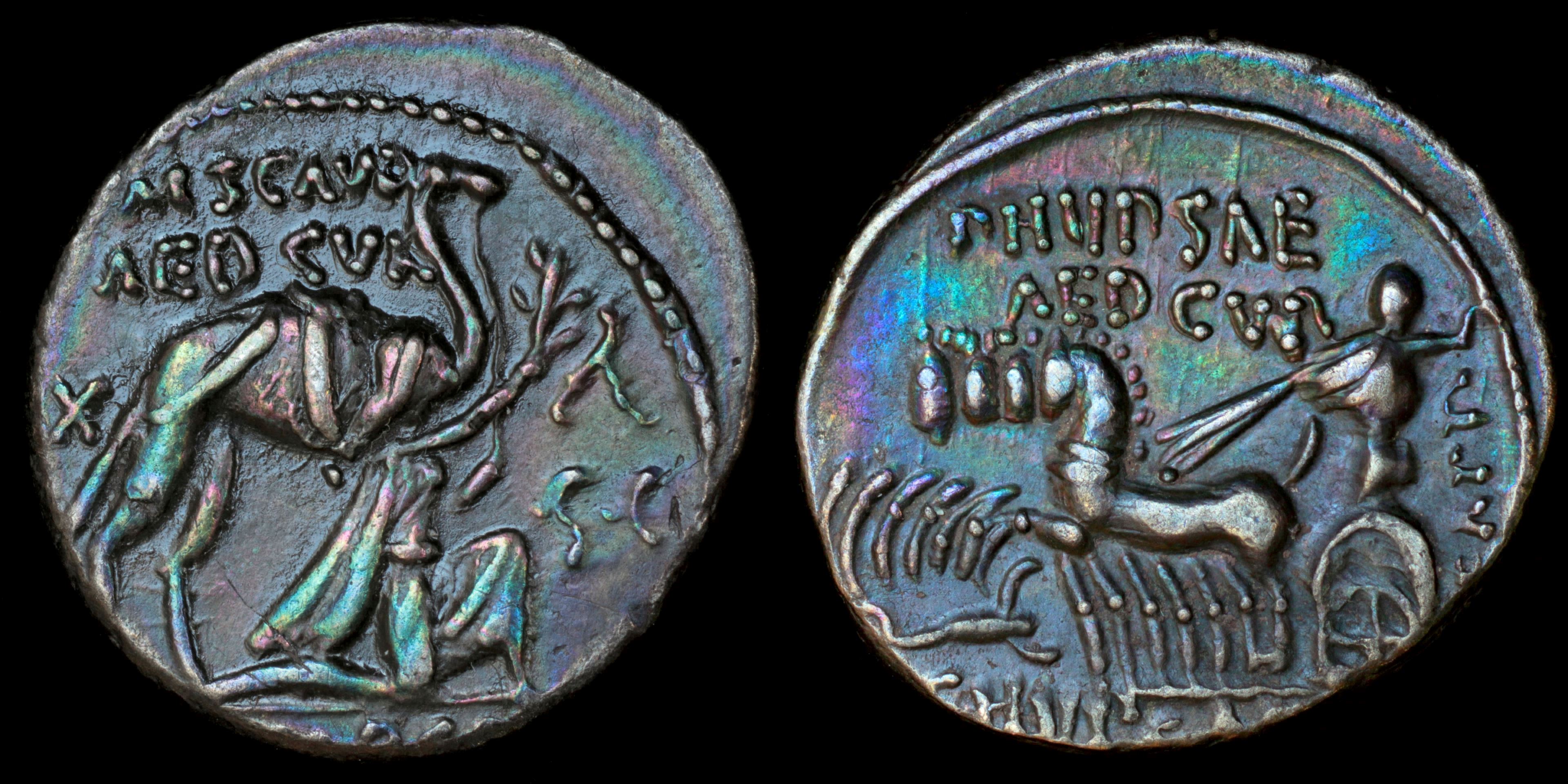M. Aemilius Scaurus was Aedilis Curulis in 58 BC, and struck coin in that respect. He was Praetor in 56 BC and Proparaetor of Sardinia in 55 BC.
He was the son of Marcus Aemilius Scaurus and Caecilia Metella Dalmatica. Scaurus lost his father when he was very young, but his education was insured by several other family friends. Pompey the Great was briefly married to his sister Aemilia Scaura and, even after her death, Pompey continued to take personal interest in the young man.
During the Third Mithridatic War, Pompey asked for Scaurus by name to become his military tribune, and charged Scaurus, at the time quaestor, with the responsibility for the Judea region, which was involved in a bloody civil war between the brothers Hyrcanus and Aristobulus.
Scaurus was supported by the First Triumvirate for the consulship in 54 BC, but was accused of extortion in his province. He was defended by Cicero, and acquitted in spite of his obvious guilt. In 53 BC, however, he was accused of ambitio (shameless bribery) and went into exile.
He was the son of Marcus Aemilius Scaurus and Caecilia Metella Dalmatica. Scaurus lost his father when he was very young, but his education was insured by several other family friends. Pompey the Great was briefly married to his sister Aemilia Scaura and, even after her death, Pompey continued to take personal interest in the young man.
During the Third Mithridatic War, Pompey asked for Scaurus by name to become his military tribune, and charged Scaurus, at the time quaestor, with the responsibility for the Judea region, which was involved in a bloody civil war between the brothers Hyrcanus and Aristobulus.
Scaurus was supported by the First Triumvirate for the consulship in 54 BC, but was accused of extortion in his province. He was defended by Cicero, and acquitted in spite of his obvious guilt. In 53 BC, however, he was accused of ambitio (shameless bribery) and went into exile.

(1)
M. Aemilius Scaurus
|
P. Plautius Hypsaeus

Obverse: Aretas, king of Nabatea, kneeling beside camel raising olive branch with fillet M SCAVR / AED CVR / EX S C / REX ARETAS
Reverse: Jupiter in quadriga left, holding reins and thunderbolt, scorpion right P HYPSAE / AED CVR / CAPT / C HYPSAE COS / PREIVE
Diameter:
18 mm
Die Orientation: -
Weight: 4 g
Die Orientation: -
Weight: 4 g
Marcus Aemilius Scaurus and Publius Plautius Hypsaeus. The moneyers were Curule aediles in 58 BC. Scaurus became praetor in 56 BC and Hypsaeus in 55 BC.
Scaurus lost his father when he was young. He was raised by Sulla as a step-son. He served as quaestor under Pompey and as proquaestor in the third Mithridatic war in 66-61 BC. In the same time conflict between Aristobulus II and Hyrcanus II broke out in Judea. Nabatean king Aretas III supported Hyrcanus and besieged Aristobulus in Jerusalem. Scaurus was send as intermediary. He sent Aretas back and settled the conflict in favour of Aristobulus. Later Pompey accused him of bribery and removed Aristobulus in 63 BC. Scaurus moved to Petra then he was called back after payment of 300 talent fine.
Hypsaeus also served as quaestor under Pompey. Reverse commemorates conquest of Volscian town Priverna by moneyer's ancestor Gaius Plautius Decianus Hypsaeus in 330-329 BC.
Scaurus was the first who depicted event from his own life on coins.
Crawford 422/1b, SRCV I 379, Sydenham 913, RSC I Aemilia 8
